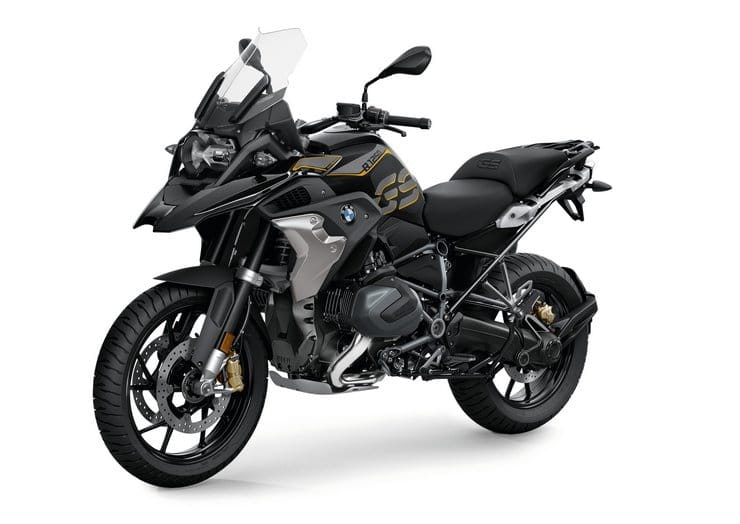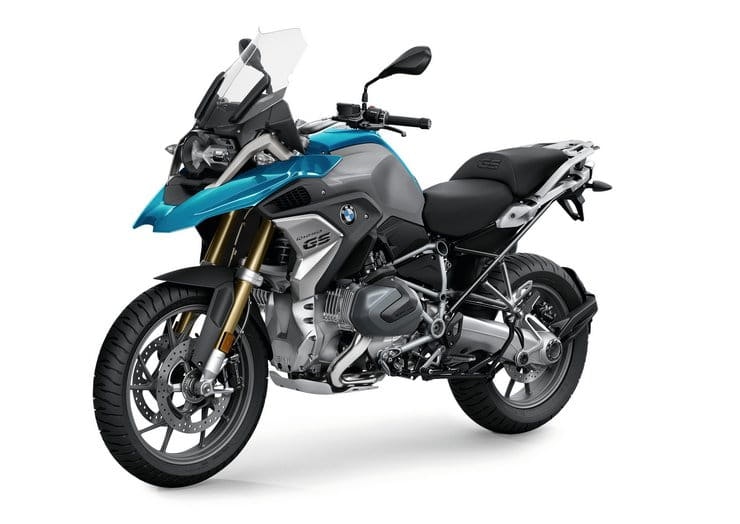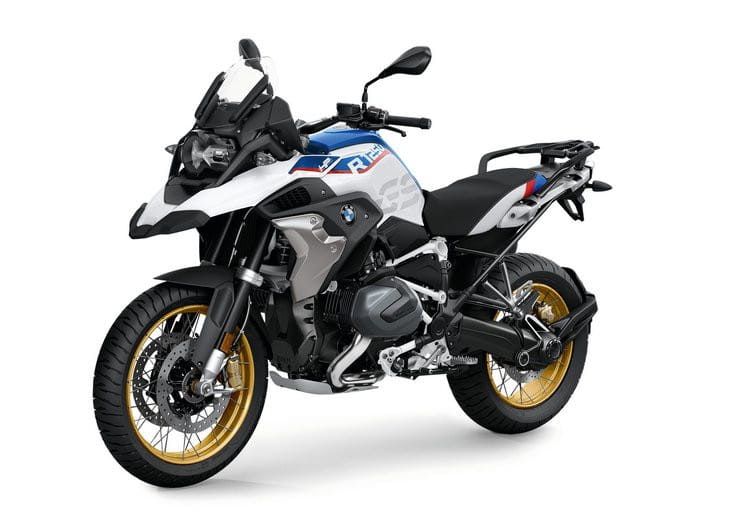Official: 2019 BMW R1250GS revealed
By Ben Purvis
Motorcycle Journalist
17.09.2018
Is this the worst-kept secret of 2019’s new bikes? Quite possibly. But it’s also a dead cert to be next year’s best-seller throughout the UK and Europe; say hello to BMW’s 2019 R1250GS, including those all important prices.
After 15 years under the ‘R1200GS’ name and bearing an 1170cc boxer twin, the 2019 model adds an extra 84cc, variable valve timing and lift, 11hp and 13lbft of torque compared to its direct predecessor. And while it looks nearly indistinguishable from the existing model, the name change to R1250GS leaves no doubt as to its superiority.
Shift-cam engine
The engine is what the new R1250GS is really all about. Now sporting a 1254cc capacity, up from 1170cc thanks to an increase in both bore and stroke from 101mm x 73mm to 102.5mm x 76mm, it’s 7% larger than before. But power is up by 9% from 125hp to 136hp at 7750rpm, and torque has increased by 14% from 91lbft (125Nm) to 105.5lft (143Nm) at 6250rpm.
BMW has managed performance increases that outstrip the growth in capacity by adding the world’s first motorcycle variable valve timing and lift system.
Called ShiftCam, details of this system leaked last week, so you can find an explanation of it here, but in short it involves putting two different sets of inlet cam lobes onto each inlet camshaft. By moving the whole camshaft forwards or backwards by a few millimetres, the engine can disengage one set of cam lobes and engage the second set, which have a completely different profile to change not only the cam timing but also its lift and duration (how far the valve opens and how long it stays open for).
That’s a big step up from the cam-phasing variable valve timing systems used by Ducati, Kawasaki and Suzuki, which alter the valve timing but not the lift or duration.
The two cam profiles mean that BMW can use one for ‘partial load’ when the engine doesn’t need its full performance, and have another, more aggressive cam profile for full-load operation.
The full-load cam profile can be a race-style design – good for power but bad for economy and emissions – while the partial-load profile can be great for economy and part-throttle response but no good for out-and-out performance. Switching between the two means there’s far less compromise than on a normal engine; BMW can have its cake and eat it.
So the new, bigger engine is more powerful but produces lower emissions. It’s also more economical than the old 1170cc design by around 4% and is claimed to provide much-improved mid-range. In fact, it has more than 120Nm of torque all the way from 3500rpm to 7750rpm, where the old engine’s outright peak was 125Nm.
Other unseen mechanical tweaks include a new camshaft drive, by toothed chain, improved oil supply, knock sensors to allow the use of lower-quality fuels and the addition of a slipper clutch.
On the outside, the visible change is the new cylinder head cover, emblazoned with the ShiftCam logo, and the new stainless-steel exhaust system.
You only have to glance at the new R1250GS to see that most of the bike’s components – engine aside – are carried over from the existing model. After all, it’s already the best-seller in BMW’s range and a bike that tops sales charts around Europe on a regular basis, so why mess with a proven recipe? BMW didn’t want a ‘New Coke’ debacle, after all.
As standard, the 2019 bike gets two riding modes – rain and road – plus traction control and hill start control, while there’s the option to upgrade to the ‘Riding Modes Pro’ set-up with more modes – Dynamic Pro, Enduro and Enduro Pro – plus Dynamic Traction Control, ABS Pro, Hill Start Control Pro and Dynamic Brake Assistance.
From on-board, the biggest change is the addition of a 6.5 inch TFT colour display as standard. Previously, this screen was an optional extra. It adds connectivity via a Bluetooth connection to your smartphone for media playback and phone calls, while if you have the free BMW Motorrad Connected App, you get arrow-based navigation, too.
HP-branded version will be called ‘Rallye’ in the UK
Visually, the 2019 bikes are pretty similar to their predecessors. Three versions of the R1250GS will be on offer; the base model – in black or blue – is joined by the R1250GS Exclusive which adds a black-painted drivetrain, black fork sliders on the trademark Telelever front end, gold brake calipers and a different radiator side trim.
All the bikes get an LED headlight as standard, while an LED running light is an option.
There’s also the R1250GS HP, which will be marketed as the ‘Rallye’ in the UK, that adds wire spoked wheels with gold rims, a white/blue/red BMW Motorsports paint scheme, a white frame and a ‘Rallye’ seat.
The HP/Rallye can also be kitted out with optional sports suspension, aimed at off-road use and featuring stiffer springs, longer travel and more ground clearance. It’s only available with the Dynamic ESA electronic suspension package, with automatic damping and load compensation.
At the moment, there’s no word on the forthcoming R1250GS Adventure model. In previous generations, the Adventure has gone on sale around a year after the normal GS, although BMW has already type-approved the R1250GS Adventure as a 2019 model, suggesting there won’t be such a long delay this time around.
2019 BMW R1250GS prices & availability
The new bike goes on sale in UK dealerships on 13th October with prices starting from £13,415 up to the top of the range R1250GS Exclusive TE at £16,500.
To insure this bike, click here.
Watch as we take the successor to the King of the Sales Chart throne and pitch it against its outgoing sibling. Click here.
Share on social media:


